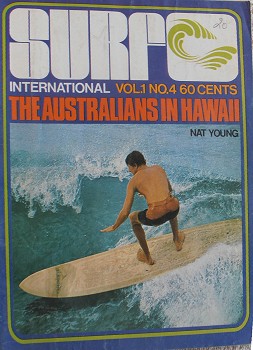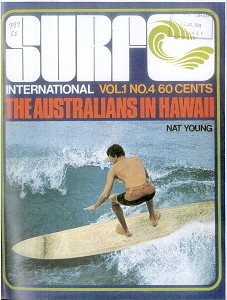 |
surfresearch.com.au
farrelly : hawaii, winter 1967 |
Midget Farrelly : Winter in Hawaii, 1967.
Midget Farrelly : Untitled (Winter in Hawaii, 1967).
Surf International
Vol. 1. No. 4 March 1968, page 9.
| home | catalogue | history | references | appendix |
 |
surfresearch.com.au
farrelly : hawaii, winter 1967 |
THE
realization
of just how good Hawaiian waves were hit me as I looked at
two-foot nor'-east
slop at Avalon.
It had been
just
twelve days since I had left this miserable scene to fly to
Hawaii.
I had been
sitting
with Russell on the plane trying to describe the difference
of Hawaiian
waves and trying to remember myself just how those waves
made a surfer
feel.
That no
matter
how good he was there would be a wave there that would make
his eyes pop,
and his body tremble as he contemplated the wipe-out.
Of course it
could be the flat the whole time?
Impossible;
I
had seen only one or two flat days in all the times I
visited.
There was
the
possibility one might wish for smaller waves if the North
Shore was being
pounded by close-out surf as it has been known to do.
Sure enough
our
first day saw Sunset running at 12 foot while the Duke
contest was in progress.
The standard of surfing was unreal.
Almost every
surfer out there was riding the big waves the same way we
tried to ride
our little waves. Sutherland surfed as if possessed.
Strauch was
smooth
but fully operative with top-to-bottom climb and drop.
Downing must
be getting close to forty but his surfing isn't.
There were
so
many kids out there completely at home in those waves.
Supposedly
it
only took time before one became used to these heavy
conditions.
The wave
itself
was about three times thicker than anything I'd seen in a
year.
Bells was a
tinkler
by comparison.
The wildest
beach
break, say Pupukea, was incredibly powerful- pretty soon
physical condition
came to mean more.
The boards
that
worked so well in Sydney were now impotent pieces of foam
and glass.
The tails
were
too wide-too much area between fin and rail to make a vital
turn at high
speeds. Russell looked good at Haliewa on a borrowed
pintail- the same
for McTavish at Sunset.
Borrowed it
was-
you couldn't buy a pintail on the island- every blank and
finished board
was accounted for.
Our first
week
was spent at Pipeline living with Pete Peterson and waking
each morning
to a roaring Banzai, never breaking under five feet and one
morning as
high as fifteen.
Just twenty
yards
out from the beach, monstrous waves that never let up and
would drown anything
less than a fish, or someone who could swim like one.
We surfed
three
places a day sometimes.
The swell
was
constantly changing its size.
In the
morning
it might be Haliewa, Velzyland at lunchtime and Chuns in the
afternoon.
From first
light
till black of night we surfed.
I never felt
the repetition one does at say Crescent or Byron.
These waves
made
you aware- you must move with speed and faultless timing.
The margin
for
error was nil when you had one of these thick beauties
hovering on your
shoulder.
Style in these waves was a result of what you did to ride the waves, not how you stood on the board. The waves offered so much challenge I'm sure some of the guys who ride them wouldn't dream of discriminating between individual approaches.
Sure Downing didn't try to make the wave every time-he was more than content to be enveloped by the shadow of the curl-like a racing driver's death wish.
Cabell's
speed
and direction were untouchable.
You may
fault
him next year in one outdated surf movie but last Christmas
he was above
all on these fast waves.
It is the
philosophy
of the surfers on the north shore, the ones who live there
year round,
to be constantly searching out a better way to ride a bigger
and fIl8~ave.
Philipe
Pomar
who lives there has attemp to improve his style in small
waves so that
he has a complete repertoire for the big surf.
He looks
nothing
like the World Champion of 1965.
Surfing in
Hawaii
is generally not that friendly out in the water.
At Makaha or
Haliewa there are those few who have complete domination of
the waves and
can make life unpleasant unless "you know someone".
At most of
the
other beaches this atmosphere does not exist.
There are
many
surfers like unassuming Bobby Cloutier who seem to be there
the minute
a
particular
break
gets good, and then disappear when it goes off.
Ego is a
big thing
but mainly between the surfer and the wave.
How could
you
compete with a person in these waves?
There were
many
places to surf, Rocky Point, Pipeline, Sunset, Laniakea and
Piddlies, and
only twelve days to do it in.
The sun
shone
most every day and the wind came off the land with the
exception of two
days.
There were
many
surfers there, some you will never see on movies.
Guys like
John
Boozer from California, who did so well at Rocky Point.
Barry
Kaniapunia,
who can penetrate a curl from just about any direction.
For these
guys
it's a quiet way of life with a lot of action in the water.
I can't wait
till next year.

|
Surf International Vol. 1. No. 4 March 1968. |
 |

| home | catalogue | history | references | appendix |